Exmark Lazer Z CT User Manual
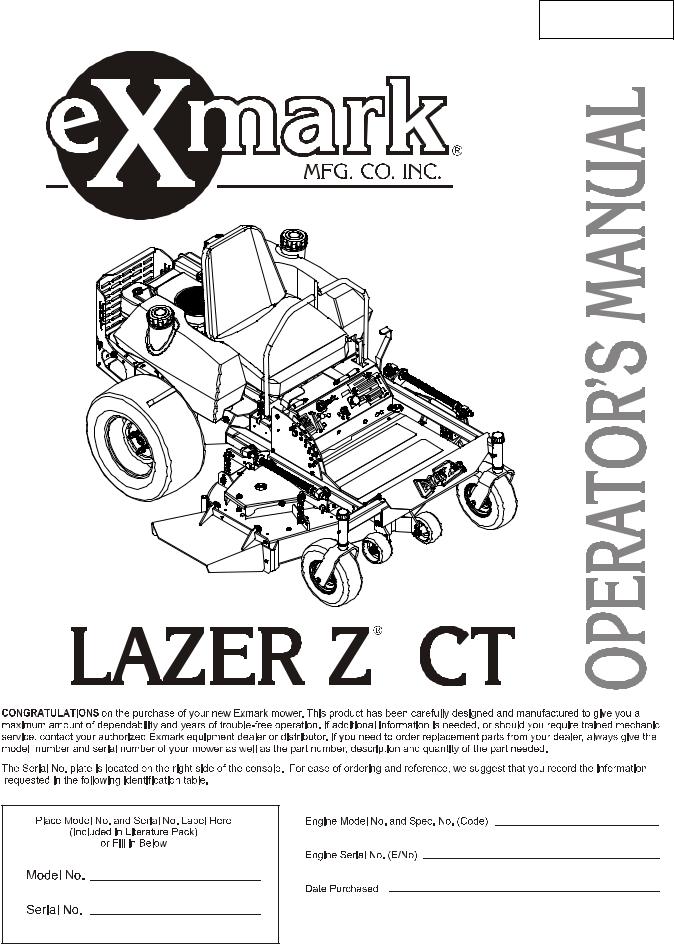
For Serial Nos.
370,000 & Higher
Part No. 103-4113

 WARNING
WARNING
POTENTIAL HAZARD
♦ This product is a piece of power equipment.
WHAT CAN HAPPEN
♦Failure to follow safe operating practices can result in serious operator injury or even death.
HOW TO AVOID THE HAZARD
♦Keep all shields, guards, and safety devices (especially the grass discharge system) in place and in proper working condition.
♦Stop engine and wait for all moving parts to stop. Remove spark plug wire(s) or remove key before adjusting, servicing, or performing maintenance.
♦If mower deck becomes clogged, stop engine and wait for all moving parts to stop. Remove spark plug wire(s) or remove key before cleaning blockage.
♦Keep hands, feet, and clothing away from power driven parts.
♦Keep off mower unless seat platform is provided.
♦Keep others off mower.
WARNING
POTENTIAL HAZARD
♦Gasoline is harmful or fatal if swallowed. Long-term exposure to vapors has caused cancer in laboratory animals.
WHAT CAN HAPPEN
♦ Failure to use caution may cause serious injury or illness.
HOW TO AVOID THE HAZARD
♦Avoid prolonged breathing of vapors.
♦Keep face away from nozzle and gas tank/container opening.
♦Keep away from eyes and skin.
♦Never siphon by mouth.
IMPORTANT
When the mower is used or operated on any California forest, brush or grass covered land, a working spark arrester must be attached to the muffler. If not, the operator is violating state law, Section 4442 Public Resource Code. To acquire a spark arrester for your unit, see your Engine Service Dealer.
Exmark reserves the right to make changes or add improvements to its products at any time without incurring any obligation to make such changes to products manufactured previously. Exmark, or its distributors and dealers, accept no responsibility for variations which may be evident in the actual specifications of its products and the statements and descriptions contained in this publication.
i
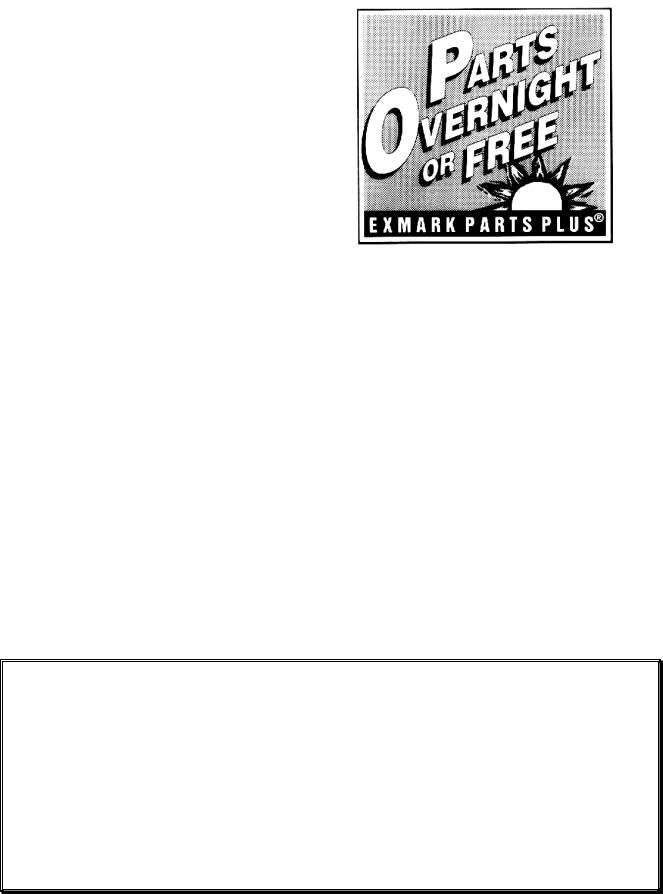
EXMARK PARTS PLUS PROGRAM
EFFECTIVE DATE: September 1, 1995
Program
If your Exmark dealer does not have the Exmark part in stock, Exmark will get the parts to the dealer the next business day or the part will be FREE* Guaranteed!!
How the Program Works
1.If dealer does not have part in stock for a "down" unit at the time of request by customer, the dealer contacts his
distributor by 1:00 p.m., local time, and requests Exmark Parts Plus shipment of six (6) line items or less.
2.Distributor ships part(s) to dealer or customer, as requested by dealer, same day, overnight UPS Distributor bills dealer for part and freight charges where applicable.
3.If distributor does not have the part(s) in stock to satisfy Exmark Parts Plus order, he contacts Exmark by 3:00 p.m., central time, with an Exmark Parts Plus order of six (6) line items or less.
4.If order is received by 3:00 p.m. central time, Exmark ships part(s) direct to dealer or customer, as requested by distributor, same day, overnight UPS, Exmark bills the distributor for parts and shipping charges, where applicable.
5.The customer pays for the part and freight if it is shipped under the Exmark Parts Plus and if it arrives in accordance to the program.
6.Who pays for the part and freight if it fails to arrive overnight in accordance to the program?
A.Under any circumstance the customer does not pay.
B.If the part does not arrive overnight due to:
1.The dealer not submitting the Exmark Parts Plus order to his Exmark distributor by 1:00 p.m., the dealer pays for the part and freight.
2.The Distributor being unable to ship the part the same day or not submitting the Exmark Parts Plus order to Exmark by 3:00 p.m., central time, the Distributor pays for the part and freight.
3.Exmark being unable to ship the part and the Exmark parts order is received by 3:00 p.m., central time, Exmark pays for the part and freight.
4.If the part does not arrive overnight due to the shipper (UPS), the shipper pays for the freight and Exmark pays for the part.
The following restrictions apply -- The Exmark Parts Plus Program is available only through participating Exmark Dealers and applies only to orders submitted on this program Monday through Thursday. Parts Plus service is available only in the 48 contiguous United States. UPS has initiated a Saturday delivery program to many areas of the continental United States and can be requested for an overnight shipment on Friday to be delivered Saturday. The next day air charge, plus the Saturday delivery fee will be the responsibility of the purchaser. Exmark Mfg. will assume no responsibility for Saturday delivery shipments. To qualify, all Exmark Parts Plus orders must be received by Exmark by 3:00 p.m., central time. Orders must be six (6) line items or less. Exclusions from the Exmark Parts Plus Program are: Any wholegood or accessory in its entirety, engines and engine replacement parts, 5-speed Peerless transmissions and 5- speed transaxles, hydraulic or hydrostatic wheel motors, cutter decks and engine decks or any item exceeding United Parcel Service size and weight restrictions.
Due to UPS restrictions, aerosol spray paint is considered a hazardous material and cannot be shipped via UPS next day or Second Day Air.
Exmark Manufacturing stocks a limited supply of parts for transaxles, pumps and wheel motors. These parts can be ordered for Next Day Air shipment but will not be guaranteed per the Parts Plus Program.
ii
CONGRATULATIONS on the purchase of your Exmark Mower. This product has been carefully designed and manufactured to give you a maximum amount of dependability and years of trouble-free operation.
OPERATOR'S MANUAL
This manual contains assembly, operating, maintenance, adjustment, and safety instructions for your Exmark mower.
BEFORE OPERATING YOUR MOWER, CAREFULLY READ THIS MANUAL IN ITS ENTIRETY.
By following the operating, maintenance, and safety instructions, you will prolong the life of your mower, maintain its maximum efficiency, and promote safe operation.
If additional information is needed, or should you require trained mechanic service, contact your authorized Exmark equipment dealer or distributor.
All Exmark equipment dealers and distributors are kept informed of the latest methods of servicing and are equipped to provide prompt and efficient service in the field or at their service stations. They carry ample stock of service parts or can secure them promptly for you from the factory.
All Exmark parts are thoroughly tested and inspected before leaving the factory, however, attention is required on your part if you are to obtain the fullest measure of satisfaction and performance.
iii
|
TABLE OF CONTENTS |
|
1. SAFETY |
PAGE |
|
1.1 |
Safety Alert Symbol............................................................................. |
1 |
1.2 |
Training ............................................................................................... |
1 |
1.3 |
Preparation....................................................................................... |
1-3 |
1.4 |
Operation.......................................................................................... |
4-7 |
1.5 |
Maintenance & Storage....................................................................... |
7 |
1.6 |
Safety Signs ..................................................................................... |
8-9 |
2. SPECIFICATIONS |
|
|
2.1 |
Model Numbers ................................................................................. |
10 |
2.2 |
Engine ............................................................................................... |
10 |
2.3 |
Fuel System ...................................................................................... |
10 |
2.4 |
Electrical System............................................................................... |
10 |
2.5 |
Operator Controls.............................................................................. |
10 |
2.6 |
Seat .............................................................................................. |
10-11 |
2.7 |
Hydrostatic Ground Drive System ..................................................... |
11 |
2.8 |
Tires & Wheels .................................................................................. |
11 |
2.9 |
Cutting Deck...................................................................................... |
11 |
2.10 |
Dimensions........................................................................................ |
12 |
2.11 |
Torque Requirements........................................................................ |
12 |
3. ASSEMBLY INSTRUCTIONS |
|
|
3.1 |
Uncrate Mower .................................................................................. |
12 |
3.2 |
Service Battery ............................................................................. |
12-13 |
3.3 |
Install Drive Wheels........................................................................... |
13 |
3.4 |
Check Tire Pressure.......................................................................... |
13 |
3.5 |
Install Seat Retaining Rod................................................................. |
14 |
3.6 |
Install Motion Control Levers............................................................. |
14 |
3.7 |
Position Discharge Chute.................................................................. |
14 |
3.8 |
Service Engine .................................................................................. |
14 |
3.9 |
Service Hydraulic Oil ......................................................................... |
15 |
4. OPERATION INSTRUCTIONS |
|
|
4.1 |
Controls ........................................................................................ |
15-17 |
4.2 |
Pre-Start ............................................................................................ |
17 |
4.3 |
Mowing ......................................................................................... |
17-18 |
4.4 |
Transporting ................................................................................. |
18-20 |
5. MAINTENANCE & ADJUSTMENTS |
|
|
5.1 |
Periodic Maintenance................................................................... |
20-28 |
5.2 |
Adjustments.................................................................................. |
38-33 |
6. WASTE DISPOSAL |
|
|
6.1 |
Motor Oil Disposal ............................................................................. |
33 |
6.2 |
Mercury Switch Disposal ................................................................... |
34 |
6.3 |
Battery Disposal ................................................................................ |
34 |
7. TROUBLE SHOOTING.................................................................. |
35-36 |
|
8. ELECTRICAL DIAGRAM.......................................................................... |
37 |
|
9. HYDRAULIC DIAGRAM............................................................................ |
38 |
|
10. WARRANTY......................................................................................... |
39-40 |
|
iv
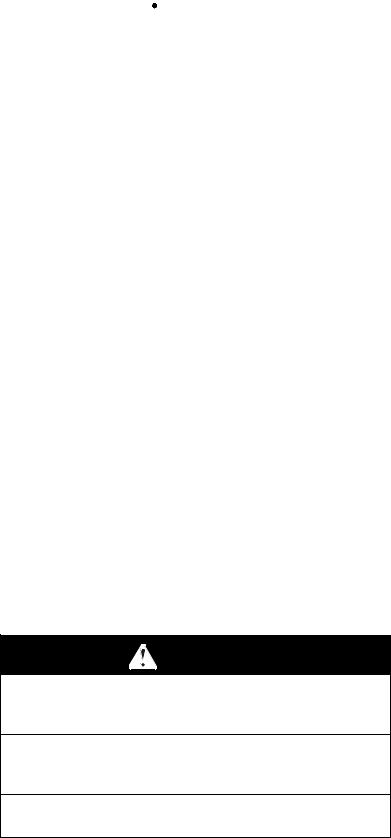
1.SAFETY
1.1 SAFETY ALERT SYMBOL
This SAFETY ALERT SYMBOL  is used both in this manual and on the machine to identify important safety messages which must be followed to avoid accidents. This symbol means:
is used both in this manual and on the machine to identify important safety messages which must be followed to avoid accidents. This symbol means:
ATTENTION! BECOME ALERT!
YOUR SAFETY IS INVOLVED!
The safety alert symbol appears above information which alerts you to unsafe actions or situations and will be followed by the word DANGER, WARNING, or CAUTION.
DANGER: White lettering / Red background. Indicates an imminently hazardous situation which, if not avoided, WILL result in death or serious injury.
WARNING: Black lettering / Orange background. Indicates a potentially hazardous situation which, if not avoided, COULD result in death or serious injury.
CAUTION: Black lettering / Yellow background. Indicates a potentially hazardous situation which, if not avoided, MAY result in minor or moderate injury.
1.2TRAINING
1.2.1Regard the Exmark mower as a piece of power equipment and teach this regard to all who operate this unit.
1.2.2Read the instructions carefully. Familiarize yourself with the controls and the proper use of the equipment. If the operator(s) or mechanic(s) can not read English it is the owner’s responsibility to explain this material to them.
1.2.3Do not allow operation of this machine by untrained personnel. Never allow children, teenagers, or people unfamiliar with these instructions to use the mower. Local regulations may restrict the age of the operator.
1.2.4Avoid mowing while people, especially children, or pets, are nearby. Keep in mind that the operator or user is responsible for accidents or hazards occurring to other people or their property.
1.3PREPARATION
1.3.1Evaluate the terrain to determine what accessories and attachments are needed to properly and safely perform the job. Only use accessories and attachments approved by Exmark.
1.3.2The use of personal protective equipment, such as (but not limited to) protection for the eyes, ears, feet, and head is recommended.
CAUTION
POTENTIAL HAZARD
♦This machine produces sound levels in excess of 85 dBA at the operator’s ear when in operation.
WHAT CAN HAPPEN
♦Exposure to sound levels of 85 dBA or above for extended periods of time can cause hearing loss.
HOW TO AVOID THE HAZARD
♦Wear hearing protection when operating this machine.
1.3.3While mowing, always wear substantial footwear and long trousers. Do not operate equipment when barefoot or when wearing open sandals.
-1 -
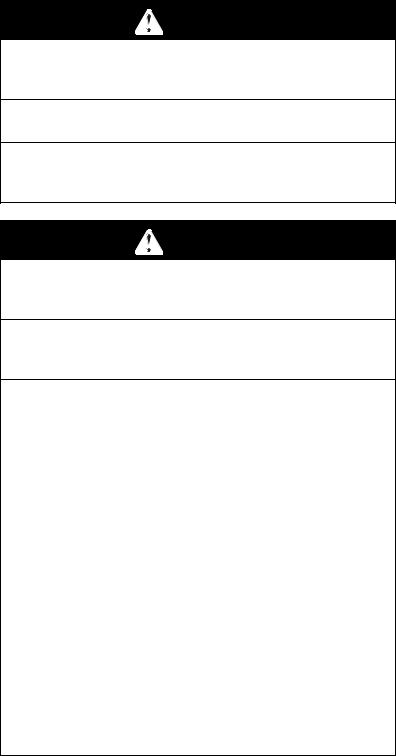
1.3.4Thoroughly inspect the area where the equipment is to be used and remove all stones, sticks, wires, bones, and other foreign objects which may damage the equipment or cause personal injury to the operator or bystanders.
WARNING
POTENTIAL HAZARD
♦Engine exhaust contains carbon monoxide, which is an odorless deadly poison.
WHAT CAN HAPPEN
♦ Carbon monoxide can kill you.
HOW TO AVOID THE HAZARD
♦Do not run engine indoors or in a small confined area where dangerous carbon monoxide fumes can collect.
DANGER
POTENTIAL HAZARD
♦In certain conditions gasoline is extremely flammable and highly explosive.
WHAT CAN HAPPEN
♦A fire or explosion from gasoline can burn you, others, and cause property damage.
HOW TO AVOID THE HAZARD
♦DO NOT smoke while refueling, and stay away from an open flame or where gasoline fumes may be ignited by spark.
♦Refuel only outdoors.
♦Store gasoline in an approved container and keep it out of the reach of children.
♦Add fuel before starting the engine. Never remove the cap of the fuel tank or add fuel when engine is running or when the engine is hot.
♦Never fill the fuel tank so that the gasoline level rises above a level that is 1/2” below the bottom of the filler neck to allow for gasoline expansion and prevent fuel spillage.
♦If fuel is spilled, DO NOT attempt to start the engine. Move away from the area of the spill and avoid creating any source of ignition until fuel vapors have dissipated.
♦Don not operate without entire exhaust system in place and in proper working condition.
- 2 -
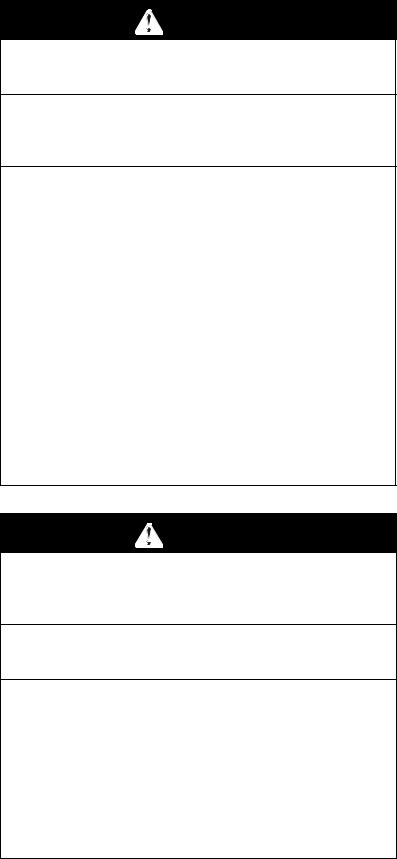
DANGER
POTENTIAL HAZARD
♦In certain conditions gasoline is extremely flammable and highly explosive.
WHAT CAN HAPPEN
♦A static charge can ignite gasoline vapors. A fire or explosion from gasoline can burn you, others, and cause property damage.
HOW TO AVOID THE HAZARD
♦Purchase and store gasoline only in an approved container.
♦Always place gasoline containers on the ground away from your vehicle before filling.
♦Do not fill gasoline containers inside a vehicle or on a truck or trailer bed because interior carpets or plastic truck bed liners may insulate the container and slow the loss of any static charge.
♦When practical, remove gas-powered equipment from the truck or trailer and refuel the equipment with its wheels on the ground.
♦If this is not possible, then refuel such equipment on a truck or trailer from a portable container, rather than from a gasoline dispenser nozzle.
♦If a gasoline dispenser nozzle must be used, keep the nozzle in contact with the rim of the fuel tank or container opening at all times until fueling is complete.
WARNING
POTENTIAL HAZARD
♦Gasoline vapor can collect inside enclosed trailers and may be ignited by electrical sparks or hot engine/exhaust components.
WHAT CAN HAPPEN
♦Explosion and fire may occur, resulting in property damage, personal injury, and/or death.
HOW TO AVOID THE HAZARD
♦Provide adequate ventilation of any enclosed trailer to prevent build up of gasoline vapors, especially at floor level.
♦Refuel only outdoors, never inside an enclosed trailer.
♦Be sure all fuel tanks and gasoline storage containers have proper caps installed to prevent spillage and minimize vapor escaping into the trailer.
♦Do not place any equipment that is leaking gasoline in an enclosed trailer.
-3 -
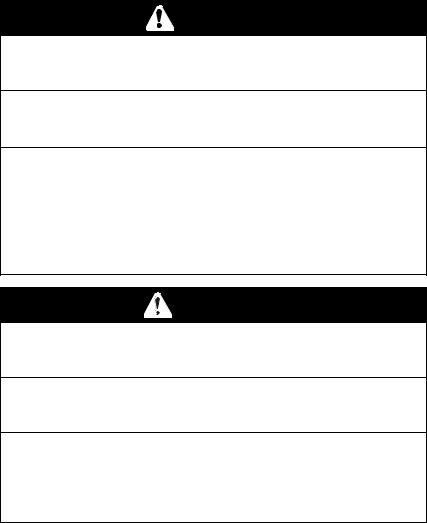
1.4 OPERATION
Although hazard control and accident prevention partially are dependent upon the design and configuration of the equipment, these factors are also dependent upon the awareness, concern, prudence, and proper training of the personnel involved in the operation, transport, maintenance, and storage of the equipment. It is essential that all Operator Safety Mechanisms be connected and in operating condition prior to use for mowing.
 WARNING
WARNING
POTENTIAL HAZARD
♦Operating engine parts, especially the muffler, become extremely hot.
WHAT CAN HAPPEN
♦Severe burns can occur on contact.
♦Debris, such as leaves, grass, brush, etc. can catch fire.
HOW TO AVOID THE HAZARD
♦Allow engine parts, especially the muffler, to cool before touching.
♦Remove accumulated debris from muffler and engine area.
♦Install and maintain in working order a spark arrester before using equipment on forest-covered, grass-covered, or brush-covered unimproved land.
WARNING
POTENTIAL HAZARD
♦Hands, feet, hair, clothing, or accessories can become entangled in rotating parts.
WHAT CAN HAPPEN
♦Contact with rotating parts can cause traumatic amputation or severe lacerations.
HOW TO AVOID THE HAZARD
♦Do not operate the machine without guards, shields, and safety devices in place and working properly.
♦Keep hands, feet, hair, jewelry, or clothing away from rotating parts.
1.4.1Give complete, undivided attention to the job at hand.
1.4.2Mow only in daylight or good artificial light, keeping away from holes and hidden hazards. NEVER carry passengers.
DO NOT operate the mower when children or others are in the area!
1.4.3When feasible, avoid operating the equipment in wet grass.
1.4.4Use EXTREME caution when mowing and/or turning on slopes as loss of traction and/or tip-over could occur. The operator is responsible for safe operation on slopes.
- 4 -
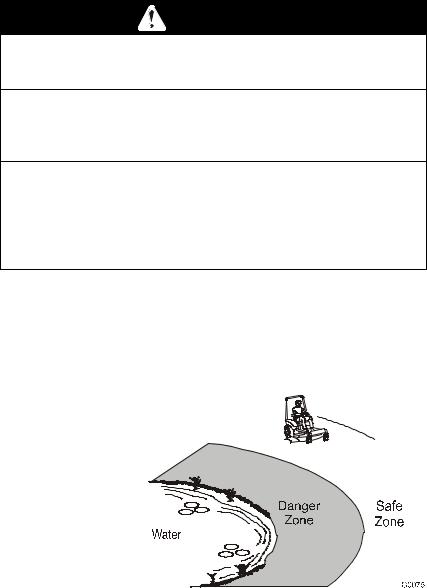
DANGER
POTENTIAL HAZARD
♦Mowing on wet grass or steep slopes can cause sliding and loss of control.
WHAT CAN HAPPEN
♦Wheels dropping over edges, ditches, steep banks, or water can cause rollovers, which may result in serious injury, death or drowning.
HOW TO AVOID THE HAZARD
♦Do not mow slopes when grass is wet.
♦Do not mow near drop-offs or near water.
♦Do not mow slopes greater than 15 degrees.
♦Reduce speed and use extreme caution on slopes.
♦Avoid sudden turns or rapid speed changes.
Note: A rollbar is available and its use is recommended for areas where there are slopes, drop-offs or water. (See section 1.4.5.)
•See inside the back cover to determine the approximate slope angle of the area to be mowed.
•Use a walk behind mower and\or a hand trimmer near drop-offs, ditches, steep banks or water. This area can be dangerous, see Figure 1.
Figure 1
SAFE ZONE FOR MOWING
•Progressively greater care is needed as the slope increases.
•Always avoid sudden starting or stopping on a slope. If tires lose traction, disengage the blades and proceed slowly off the slope.
•Avoid sudden starts when mowing uphill. Mower may tip backwards.
•Be aware that loss of traction may occur going downhill. Weight transfer to the front wheels may cause drive wheels to slip and cause loss of braking and steering.
•Watch for ditches, holes, rocks, dips, and rises that change the operating angle, as rough terrain could overturn the machine.
•Remove or mark obstacles such as rocks, tree limbs, etc. from the mowing area. Tall grass can hide obstacles.
•Use extreme care with grass catchers or attachments. These can change the stability of the machine and cause loss of control.
•Follow the manufacturer’s recommendations for wheel weights or counterweights to improve stability.
1.4.5A Rollover Protection System (ROPS) is available and its use is recommended for areas where there are slopes, drop-offs or water.
-5 -
IMPORTANT: When operating a machine with a ROPS always use the seatbelt.
•Be certain that the seat belt can be released quickly if the machine is driven or rolls into ponds of water.
•Check carefully for overhead clearances (i.e. branches, doorways, and electrical wires) before driving under any objects and do not contact them.
1.4.6Use EXTREME caution when backing up. LOOK BEHIND YOU!!
1.4.7Stop the blades when crossing surfaces other than grass and when transporting the mower to and from the area to be mowed.
1.4.8Never operate the mower with defective guards, shields, or covers. Always have safety shields, guards, switches, and other devices in place and in proper working condition.
1.4.9DO NOT change the engine governor settings or overspeed the engine. Operating an engine at excessive speed may increase the hazard of personal injury.
1.4.10Disengage PTO before starting engine.
1.4.11Start the engine carefully with feet well away from the blades.
1.4.12Keep hands, feet, and clothing away from rotating parts while the mower is being operated.
1.4.13Stop engine, wait for all moving parts to stop, and remove key:
•Before checking, cleaning or working on the mower.
•After striking a foreign object (inspect the mower for damage and make repairs before restarting and operating the mower).
•Before clearing blockages.
•Whenever you leave the mower.
Stop the engine and wait for all moving parts to stop:
•Before refueling.
•Before dumping the grass catcher.
1.4.14Before stopping the engine, place the throttle control midway between the “slow” and “fast” positions. Allow the engine to run a minimum of 15 seconds; then stop the engine.
1.4.15The fuel system is provided with a shut-off valve. The fuel shut-off valve is used to shut off the fuel:
•When the machine will not be used for a few days.
•During transport to and from the job.
•When parked inside a building.
1.4.16This mower was designed for one operator only. Keep all others away from mower during operation.
1.4.17Do Not mow with the discharge deflector raised, removed, or altered unless there is a grass collection system or mulch kit in place and working properly.
1.4.18Be aware of the mower discharge and direct discharge away from others.
1.4.19Do Not operate the mower under the influence of alcohol or drugs.
1.4.20Use extra care when approaching blind corners, shrubs, trees, or other objects that may obscure vision.
1.4.21If jump starting is required:
a)connect the positive (+) power cable from the positive post on the booster battery to the positive terminal post on the starter solenoid switch (this post has the positive battery cable attached to it).
-6 -

b)connect the negative or ground cable (-) from the negative post on the booster battery to any engine deck ground, preferably the engine block as far away from the battery as possible.
c)disconnect battery cables in the reverse order after starting.
1.5MAINTENANCE AND STORAGE
1.5.1For engine maintenance, follow the engine manufacturer’s recommendations precisely as stated in the engine manual.
1.5.2Disconnect the battery cable from the negative battery post when the unit will be allowed to sit for more than 30 days without use.
1.5.3Allowing batteries to stand for an extended period of time without recharging them will result in reduced performance and service life. To preserve optimum battery performance and life, recharge batteries in storage when the open circuit voltage drops to 12.4 volts.
Note: To prevent damage due to freezing, battery should be fully charged before putting away for winter storage.
1.5.4Keep engine, engine area, and hydraulic pump area free from accumulation of grass, leaves, excessive grease, or oil and other debris, which can accumulate in these areas. These materials can become combustible and may result in a fire.
1.5.5Store fuel in a container specifically designed for this purpose in a cool, dry place.
1.5.6Keep the mower and fuel container in locked storage to prevent children from playing or tampering with them.
1.5.7Gasoline powered equipment or fuel containers should not be stored in a basement or any enclosed area where open pilot lights or heat appliances are present.
1.5.8Maximum mowing results and safety can only be achieved if the mower is properly maintained and operated correctly.
1.5.9Check all bolts frequently to maintain proper tightness.
1.5.10Keep all guards, shields and all safety devices in place and in safe working condition.
1.5.11Frequently check for worn or deteriorating components that could create a hazard.
1.5.12All replacement parts must be the same as or equivalent to the parts supplied as original equipment.
 WARNING
WARNING
POTENTIAL HAZARD
♦Hydraulic fluid escaping under pressure can penetrate skin and cause injury.
WHAT CAN HAPPEN
♦Fluid accidentally injected into the skin must be surgically removed within a few hours by a doctor familiar with this form of injury or gangrene may result.
HOW TO AVOID THE HAZARD
♦Make sure all hydraulic fluid hoses and lines are in good condition an all hydraulic connections and fittings are tight before applying pressure to hydraulic system.
♦Keep body and hands away from pinhole leaks or nozzles that eject high pressure hydraulic fluid.
♦Use cardboard or paper, not your hands, to find hydraulic leaks.
♦Safely relieve all pressure in the hydraulic system by placing the motion control levers in neutral and shutting off the engine before performing any work on the hydraulic system.
-7 -
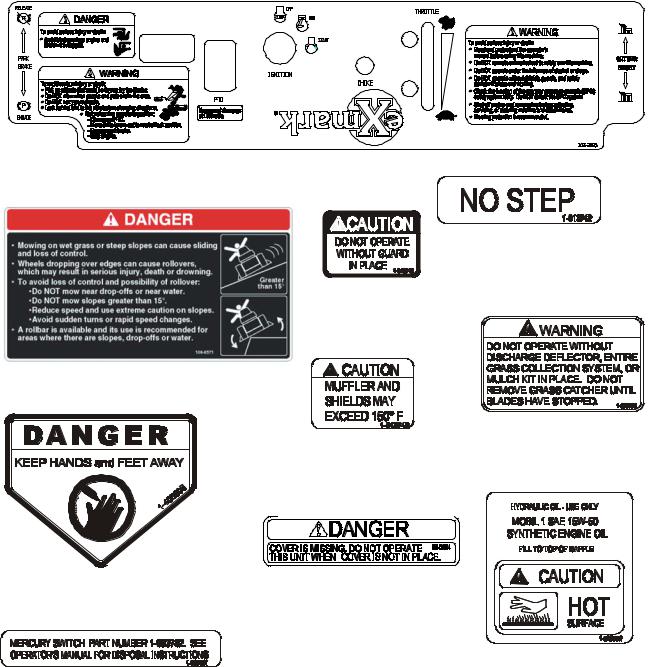
1.6SAFETY SIGNS
1.6.1Keep all safety signs legible. Remove all grease, dirt, and debris from safety signs and instructional labels.
1.6.2Safety signs must be replaced if they are missing or illegible.
1.6.3When new components are installed, be sure that current safety signs are affixed to the replaced components.
1.6.4New safety signs may be obtained from your authorized Exmark equipment dealer or distributor or from Exmark Mfg. Co. Inc.
1.6.5Safety signs may be affixed by peeling off the backing to expose the adhesive surface. Apply only to a clean, dry surface. Smooth to remove any air bubbles.
1.6.6Familiarize yourself with the following safety signs and instruction labels. They are critical to the safe operation of your Exmark commercial mower.
PART NO. 103-3995
LOCATION: Center of Console
PART NO. 106-6571
LOCATION: Top Center of Floorpan
PART NO. 1-403005
LOCATION: Left and Right Corners
of Mower Deck
PART NO. 1-643401
LOCATION: On Tilt Switch
PART NO. 1-513742
LOCATION: On Top of Mower Deck Belt
Shields, Left and Right Sides
PART NO. 1-513748
LOCATION: Bottom of
Floorpan
PART NO. 1-513746 |
PART NO. 1-303508 |
LOCATION: Front Right Corner |
|
LOCATION: On Engine |
Top of Mower Deck |
Blower Housing |
|
PART NO. 98-5954
LOCATION: Under Mower Deck
Belt Shield(s)
PART NO. 1-523552
LOCATION: Top of Hydraulic
Reservoir
- 8 -
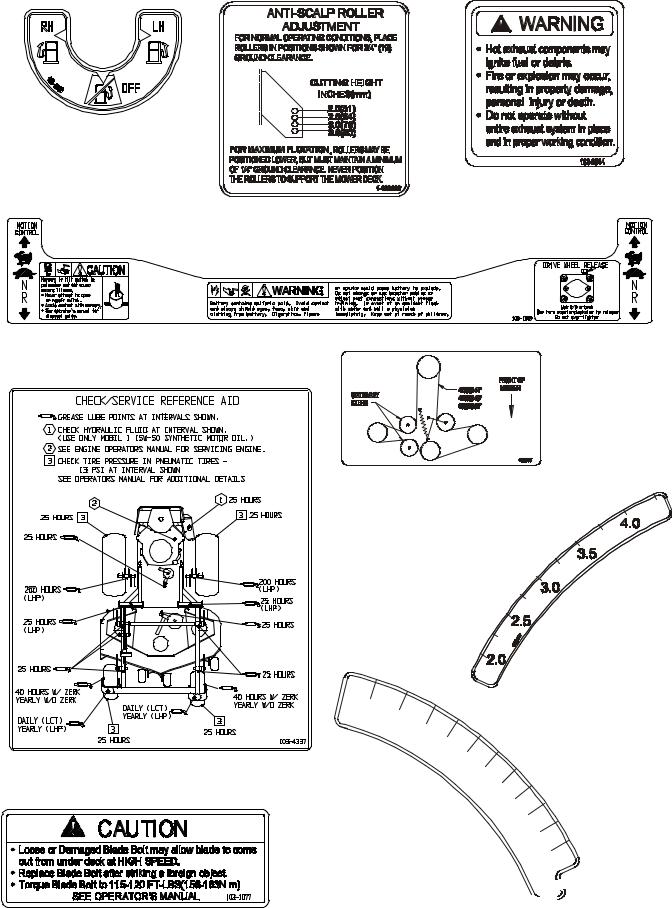
PART NO. 103-0262
LOCATION: Below Center of
Console
PART NO. 103-2644
LOCATION: Top of Hydraulic Reservoir
PART NO. 1-633922
LOCATION: Front Left Corner
Top of Mower Deck
PART NO. 103-1997
LOCATION: Top of Console Under Seat
PART NO. 103-4337
LOCATION: Bottom Side of Floor Pan
PART NO. 103-1077
LOCATION: On Top LH Side of Mower Deck
PART NO. 1-653477
LOCATION: Left of Center on Mower
Deck, Under Floor Pan
|
|
PART NO. 1-653147 |
4.5 |
|
LOCATION: Lefthand Side of |
653140 |
4.0 |
Cutting Height |
|
Adjustment Plate |
3.5
3.0
2.5
2.0
1.5
PART NO. 1-653140  LOCATION: RH Side of Cutting Height
LOCATION: RH Side of Cutting Height
Adjustment Plate
- 9 -
2. SPECIFICATIONS
2.1 MODEL NUMBER:
Serial Nos. 370,000 & Higher: LCT4418KC; LCT4818KC
2.2ENGINE:
2.2.1Engine Specifications: See Your Engine Owner’s Manual
2.2.2 RPM: Full Speed: 3600 RPM (No Load) Idle: 1500 RPM
2.3FUEL SYSTEM
2.3.1Capacity: 8 gal. (30 L.)
2.3.2Type of Fuel: Regular unleaded gasoline, 87 octane or higher.
2.3.3Fuel Filter: For Kohler: Replaceable in-line 15 Micron Kohler P/N 2405002
2.3.4Fuel Shut-Off Valve: 1/4 turn increments (left tank, “OFF”, right tank)
2.4ELECTRICAL SYSTEM
2.4.1Charging System: Flywheel Alternator
2.4.2Charging Capacity: 15 amps
2.4.3Battery Type: BCI Group U1
2.4.4Battery Voltage: 12 Volt
2.4.5Polarity: Negative Ground
2.4.6Fuses: Two 20 amp blade type
2.4.7Safety Interlock System:
PTO must be disengaged, brake engaged, and motion control levers out
(neutral lock) to start engine. (It is not necessary for the operator to be in the seat to start the engine.)
Operator must be in seat when PTO is engaged, brake is disengaged, or motion control levers are moved in or engine will stop.
Engine will stop if either the left, the right, or both levers are moved from neutral lock position while brake is engaged.
2.4.8Tilt Switch: Shuts off the engine when the unit is tilted more than 60° from horizontal.
2.5OPERATOR CONTROLS
2.5.1Steering and Motion Control:
Separate levers, on each side of the console, control speed and direction of travel of the respective drive wheels.
Steering is controlled by varying the position of the levers relative to each other. Moving motion control levers outward (in slots) locks the drive system in neutral. Motion control levers are adjustable to two heights.
2.5.2PTO Switch: Engages electric clutch (to drive belt) which engages mower blades.
2.5.3Parking Brake Lever: Engages parking brake.
2.5.4Deck Height Adjustment Lever: Sets cutting height to desired position.
2.6SEAT
2.6.1Type: Standard seat: high back, foam padded (internal spring
suspension).
Optional suspension seat: high back, low profile foam-in-place cushion (dampened, adjustable spring suspension) with armrests.
- 10 -
